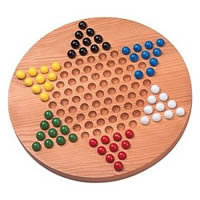
Opponent’s pieces may be jumped, as in checkers, but the jumped piece stays in place. When a path is blocked by an opponent’s piece or pieces, you may jump them. The two possible first moves if starting with the centre piece are shown below. Pieces may only be moved along the paths indicated by the diagonal lines on the board. The object of the game is to move all of your pieces from their home triangle to the same colour triangle on the opposite side of the board. Decide the order of play by flipping a coin. If you have ten, you can fill the next row as well. You will need a minimum of six pieces -and a maximum of ten- per player. A larger bean, like a white kidney bean, would be better.) If you are using white beans, you can colour them with felt pen, or watercolours, or even nail polish if you have some distinctly different colours. You can find instructions for folding them here.) Playing pieces can be made from a variety of things you likely already have around the house: buttons, beans, washers, coins, Chinese lucky stars folded from magazine pages… (The Chinese lucky stars were the easiest to handle when playing. The black and white version is suitable for hand-colouring. If you print on card stock your board will be more durable, but regular copy paper is fine. The files will print on either A4 or 8.5 x 11″ stock. You will need to use either the ‘Fit to page’ setting or the ‘Center’ setting, depending on your printer.
Ten play chinese checkers download#
(This is the smaller board used in Japan and Korea.) Download either Chinese Checkers Colour or Chinese Checkers B&W and print. If you would like to play Stern-Halma and don’t own a board, you can print a small version. The “Stern” (German for star) refers to the board’s star shape (in contrast to the square board used in Halma). The game was invented in Germany in 1892 under the name “Stern-Halma” as a variation of the older American game Halma. In doing some research I discovered that Chinese Checkers are not Chinese at all.ĭespite its name, the game is not a variation of checkers, nor did it originate in China or any part of Asia (whereas the game 象棋 xiangqi, or “Chinese chess”, is from China). At bottom are some of the company's products, including Star Checkers.īallard's Star Checkers game is on display in the main gallery of the Kansas Museum of History.I have been working on an artist’s book for the March #areyoubookenough_hexagon challenge on Instagram. The middle photo is a corner of the manufacturing department. Ballard (at back, left) in his office at Ballard Manufacturing.

The images at bottom right appeared in an article entitled "Topeka Product Enjoying Nation-Wide Sales," which appeared in the Kansas Business Magazine for April 1938. The winner was the first player to move all ten of his marbles from one point of the star to the point directly opposite by means of checkers-like jumps. As with Halma, from two to six players could play Star Checkers. The need for a faster and more accurate method of parceling out the marbles led Ballard to invent a device that counted and dispensed them automatically.Ĭhinese checkers was not a new game it was a simplified variation of a European board game called Halma, which was developed around 1880 and had its own run of popularity in America during the last quarter of the nineteenth century. Ballard employed several workers just to count out the marbles for each game-10 each of six different colors. By the spring of 1938 the Ballard Manufacturing Company of Topeka was shipping out around 15,000 Star Checkers games a month (including 500,000 to 700,000 marbles) to Woolworth stores nationwide, with preparations underway to produce 4,000 sets daily to meet order demands.

He had found success marketing products such as towel racks, potlifters, and cat-shaped wooden match holders.īut Star Checkers was perhaps Ballard's biggest success. This wasn't Ballard's first foray into the novelty business.

Ballard called his Chinese Checkers knock-off the Star Checkers game. A Topeka manufacturer took advantage of the nationwide fad by developing his own version of the game. In the 1930s a craze for the board game commonly known as Chinese Checkers swept across America.


 0 kommentar(er)
0 kommentar(er)
